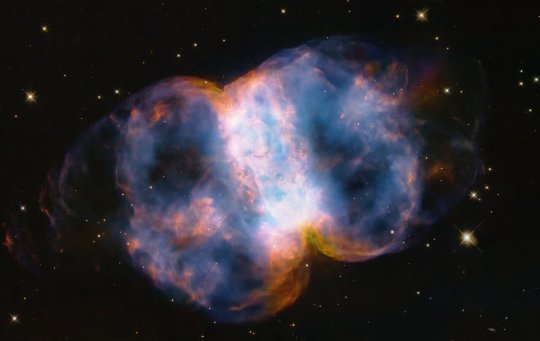#dumbbell nebula
Explore tagged Tumblr posts
Text






Planetary Nebulae: clouds from dying stars © AlfonsoJoseMer1
#nebula#space#stars#astrophotography#solar system#planet#galaxy#universe#nasa#astronomy#cosmos#night sky#dumbbell nebula#ring nebula
951 notes
·
View notes
Text

The Dumbbell Nebula, M27 // Michael
#astronomy#astrophotography#nebula#emission nebula#planetary nebula#dumbbell nebula#messier#messier 27#M27#NGC 6853#vulpecula
110 notes
·
View notes
Text


m27 (dumbbell nebula) | 9/7/24
first: 68 sec
second: 20 min
55 notes
·
View notes
Text

Little Dumbbell Nebula (also known as Messier 76, M76, or NGC 650/651) located 3400 light-years away in the northern circumpolar constellation Perseus. The photogenic nebula is a favourite target of amateur astronomers.
The release, images and videos are available on: https://esahubble.org/news/heic2408/
25 notes
·
View notes
Photo

M27: The Dumbbell Nebula
Image Credit & Copyright: Patrick A. Cosgrove
#art#photography#M27#nebula#dumbbell nebula#nasa#cosmos#cosmic#universe#fox constellation#vulpecula#patrick A. cosgrove#wallpaper#space wallpaper#blast#stars
36 notes
·
View notes
Text

The Dumbbell Nebula
"The Dumbbell nebula, also known as Messier 27, pumps out infrared light in this image from NASA Spitzer Space Telescope. Planetary nebulae are now known to be the remains of stars that once looked a lot like our sun."
Image and information from NASA
17 notes
·
View notes
Photo
[source]

M27: The Dumbbell Nebula
Credits: John Hayes
70 notes
·
View notes
Text
my space photo was too massive and Tumblr said "omg! take it back! it's too big!", but not in a flattering way. 😔
Anyway, here he is after the reduction surgery. 🥺

0 notes
Text


Dumbbell nebula (m27)
1 note
·
View note
Text

M27: The Dumbbell Nebula - July 29th, 1995.
“The Dumbbell Nebula is a beautiful red and blue planetary nebula in the constellation of Vulpecula. It is the 27th object on Charles Messier's list of diffuse sky objects, and so is referred to as M27. Its high surface brightness makes it a good target for small telescopes. The term planetary nebula, used to describe this general class of objects, is misleading. Although these objects may appear round and planet-like in small telescopes, astronomers have determined them to be stars surrounded by cocoons of gas blown off in the late stages of evolution.”
1 note
·
View note
Text
Bowflex SelectTech 552 Adjustable Dumbbells
0 notes
Text

The Dumbbell Nebula, M27 // Christopher Stobie
#astronomy#astrophotography#nebula#emission nebula#planetary nebula#dumbbell nebula#apple core nebula#messier#messier 27#M27#NGC 6853#vulpecula
90 notes
·
View notes
Text

m27 (dumbbell nebula) | 9/1/24 | 3 min
21 notes
·
View notes
Text
Dumbell Nebula
Very pleased with these photos I took this week using the OU’s remote telescope (COAST) The Dumbbell Nebula (also known as M 27, or NGC 6853) is a planetary nebula in the constellation Vulpecula, at a distance of about 1,360 light years from the Earth. Its central star, a white dwarf, is the largest white dwarf yet discovered.

View On WordPress
0 notes
Photo
Excellent image of the Dumbbell Nebula. More extension than I have seen to date.

2023 May 30
M27: The Dumbbell Nebula Image Credit & Copyright: Patrick A. Cosgrove
Explanation: Is this what will become of our Sun? Quite possibly. The first hint of our Sun’s future was discovered inadvertently in 1764. At that time, Charles Messier was compiling a list of diffuse objects not to be confused with comets. The 27th object on Messier’s list, now known as M27 or the Dumbbell Nebula, is a planetary nebula, one of the brightest planetary nebulae on the sky and visible with binoculars toward the constellation of the Fox (Vulpecula). It takes light about 1000 years to reach us from M27, featured here in colors emitted by sulfur (red), hydrogen (green) and oxygen (blue). We now know that in about 6 billion years, our Sun will shed its outer gases into a planetary nebula like M27, while its remaining center will become an X-ray hot white dwarf star. Understanding the physics and significance of M27 was well beyond 18th century science, though. Even today, many things remain mysterious about planetary nebulas, including how their intricate shapes are created.
∞ Source: apod.nasa.gov/apod/ap230530.html
116 notes
·
View notes
